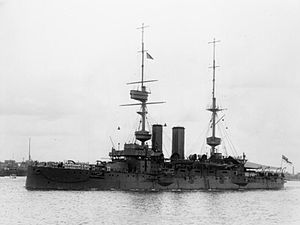HMS Bulwark (1899)

HMS Bulwark
|
|
| History | |
|---|---|
|
|
|
| Class and type: | Formidable- or London-class pre-dreadnought battleship |
| Name: | HMS Bulwark |
| Ordered: | 27 June 1898 |
| Builder: | Devonport Dockyard |
| Laid down: | 20 March 1899 |
| Launched: | 18 October 1899 |
| Completed: | March 1902 |
| Commissioned: | 11 March 1902 |
| Fate: | Destroyed by internal explosion, 26 November 1914 |
| General characteristics | |
| Displacement: | 15,366 long tons (15,613 t) (load); 15,995 long tons (16,252 t) (deep) |
| Length: | 431 ft 9 in (131.60 m) |
| Beam: | 75 ft (22.9 m) |
| Draught: | 27 ft 3 in (8.31 m) (load); 28 ft 2 in (8.59 m) (deep) |
| Propulsion: |
|
| Speed: | 18 kn (20.7 mph; 33.3 km/h) |
| Range: | 5,550 nmi (6,390 mi; 10,280 km) at 10 kn (11.5 mph; 18.5 km/h) |
| Complement: | 750; 766 as flagship in 1904 |
| Armament: |
|
| Armour: | |
| Notes: | Cost £1,065,816 |
HMS Bulwark belonged to a sub-class of the Formidable-class of pre-dreadnought battleships of the Royal Navy known as the London class. Entering service with the Royal Navy in 1902, she sailed with the Mediterranean Fleet until 1907. She then served with the Home Fleet, for a time under Captain Robert Falcon Scott. After a refit in 1912, she was assigned to the 5th Battle Squadron.
Following the outbreak of the First World War, Bulwark, along with the rest of the squadron, was attached to the Channel Fleet, conducting patrols in the English Channel. On 26 November 1914, while anchored near Sheerness, she was destroyed by a large internal explosion with the loss of 736 men. There were only 14 survivors of the explosion and of these 2 died later in hospital. The explosion was likely to have been caused by the overheating of cordite charges that had been placed adjacent to a boiler room bulkhead.
HMS Bulwark was laid down at Devonport Dockyard on 20 March 1899 and launched on 18 October 1899. She began trials in May 1901 and was completed in March 1902.
Like the first three Formidable-class ships, Bulwark and her four London-class sisters were similar in appearance to and had the same armament as the Majestic and Canopus classes that preceded them. The Formidables and Londons are often described as improved Majestics, but in design were essentially enlarged Canopuses; while the Canopuses took advantage of the greater strength of the Krupp armour so they could remain the same size as the Majestics, with increased tonnage devoted to speed and less to armour without sacrificing protection, the Formidables and Londons used Krupp armour to improve protection without reducing their size. The Formidables and Londons thus were larger than the two preceding classes, and enjoyed both greater protection than the Majestics and the higher speed of the Canopuses. The armour scheme of the Formidables and Londons was similar to that of the Canopuses, although – unlike in the Canopuses – the armour belt ran all the way to the stern; it was 215 ft (66 m) long and 15 ft (4.6 m) deep and 9 in (23 cm) thick, tapering at the stem to 3 in (7.6 cm) thick and 12 ft (3.7 m) deep and at the stern to 1.5 in (3.8 cm) thick and 8 ft (2.4 m) deep. The main battery turrets had Krupp armour, 10 in (25 cm) on their sides and 8 in (20 cm) on their backs.
...
Wikipedia
